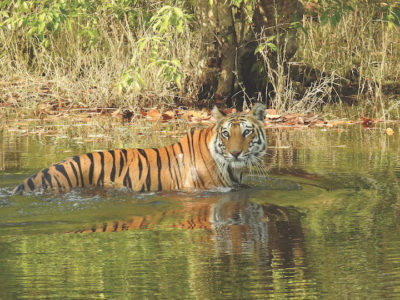In search of the wild Bengal tiger, safaris, and more in India

SPOTTY is named for the markings on her forehead. Photo by Suzan Filipek
I went to India in search of the Bengal tiger.
So, after my first day on safari at Kanha National Park I was disappointed to be heading back near sunset with not a tiger in sight.
My disappointment quickly vanished when a male tiger lumbered out from the bush and onto the dirt road ahead of us.
“What’s that?” I asked my driver / guide and naturalist Raskesh Solanki, as I tried to make out the blurry creature.
“A tiger! A tiger!” he whispered enthusiastically. “Take a video!”
Fumbling with my phone, I managed to move it to video mode, and could now, through the lens, see this magnificent creature walking toward us.
I expected Rakesh to back up and get out of the tiger’s way. But to my surprise, he reversed just enough to let the tiger keep approaching… until we hit a jeep stopped behind us. And, there were more behind it. The tiger was drawing a traffic jam.
With nowhere else to go, the king of the jungle passed in front and to the side of our open-air jeep within a few feet of me.
My video went dark at this point as I anxiously looked to my guide.
Rakesh assured me all was well and, sure enough, when I glanced back, the tiger had continued his relaxed pace, tail swaying like a house cat as he lumbered on the path alongside the stacked jeeps and into a ravine below.
Why India?
When people heard I was taking a trip to India, they would often ask if it was for a spiritual journey or a yoga retreat.
Nope, I’d say. Though in retrospect it was sort of a spiritual trek.
Besides seeing the beauty of the golden orange-and-black-striped tiger in the wild, I wanted to witness the incredible conservation effort underway in India — home to 1.4 billion people.
The trip was a longtime dream of mine, and it didn’t disappoint. In one week, we went on a whirlwind 13 safaris in two national parks and saw 20-plus of India’s 2,500 Bengal tigers left in the wild.
In short, it was the trip of a lifetime.
Safari drives
The safari drives took place in the early morning and late afternoon, to avoid the scorching heat of midday in Central India — India’s summer is the best time to see the tiger as it forages out in search of water. Besides Kanha, (the inspiration for Kipling’s “The Jungle Book” and where we stayed at the amazing Singinawa Jungle Lodge), we visited Bandhavgarh, a former maharaja’s game reserve, where we stayed at the Tree House Hideaway.
The second week we visited 1,000-year-old temples at Khajuraho, the holy Hindu city of Varanasi on the Ganges River, the Taj Mahal and Delhi.
Serving the tiger
India is a vital, exciting and youthful country — the median age is 27. And, while the country has its share of social problems, it has managed to save its tiger from extinction (it’s listed as “endangered”), which is where it was headed before Prime Minster Indira Ghandi spearheaded the Wildlife Protection Act in 1972 and Project Tiger in 1973.
While a success — there are 50 tiger reserves in India, which is home to 70 percent of the world’s 4,000 tigers (according to the World Wildlife Fund) — there are significant threats by poachers from China. Loss of habitat is another key concern, and local villagers are not happy with the beasts living in close proximity. The parks are not fenced, at least the two I visited, and sometimes a hungry tiger leaves the protected park for an easy meal, a villager’s cow.
The tiger is the only cat that likes water, and we saw more than one cooling off in water holes, including Spotty, named after the marking on her forehead. The eight-year-old cat almost seemed to pose for the camera, like a Bollywood star. She grew up with the jeeps within feet of her, so she thinks they’re part of nature, our guide explained.
Park entrance is booked months in advance; and, during the season, several guides with tourists drive in each day. Occasionally, the elusive sloth bear or leopard is spotted, but more likely, visitors will see many of the park’s countless birds, including eight types of eagles, storks, woodpeckers, the turquoise-feathered Indian roller, plus hundreds of deer, wild pigs, jackals, the bison-like gaurs and langurs and rhesus monkeys.
Our tour company, Delhi-based Nature Safari India, was key to our trip’s success, from help getting a visa to meeting us upon arrival and reserving the safaris.
And, mostly for taking us to the heart and soul of India’s wildlife reserves for a truly transcendent experience.
Category: Entertainment
